Loudness and SPL Display
Loudness Analysis and Handling with Easy to Read Instruments: Loudness and SPL Display
Graphical and numerical instruments for loudness measurements according to current standards
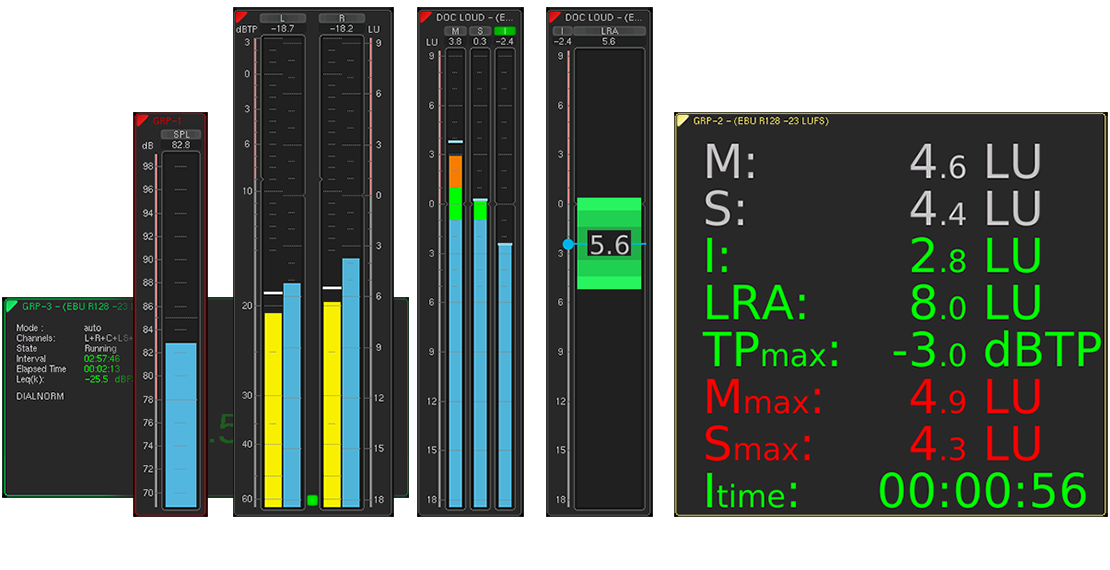
The Loudness and SPL Display license expands the basic 4-channel PPM with graphical and numerical instruments for Loudness measurements as described in current guidelines (EBU R128, ITU-R BS.1770-4/1771-1, ATSC A/85, ARIB, OP-59, AGCOM, CALM, LEQ(M), TASA, SAWA), and the LRA instrument for the graphical display of the Loudness Range. A customer-specific mode allows the user to modify parameters.
In addition, the license provides the SPL display mode with various weighting filters and integration times as well as reference level adjust to calculate an SPL value from an electrical signal. Dialnorm values can be meausred with activated Multichannel Mode license (SW20001).
If you additionally activate the Timecode Reader license (SW20008), you are able to execute timecode-based loudness measurements and loudness recalculation.
Loudness Sum
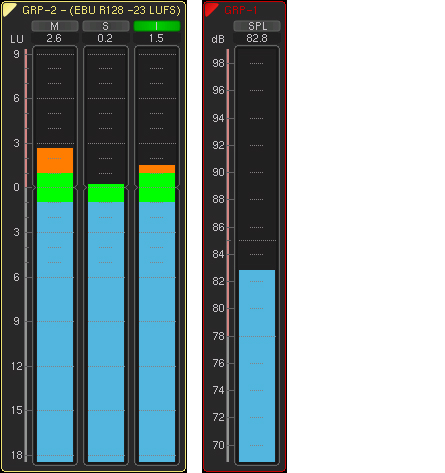
With the Loudness Sum instrument you get a bargraph display of the summed Loudness values M, S, and/or I of a Loudness measurement acc. to EBU R128, ITU BS.1770-4/1771-1, ARIB, ATSC A/85, OP-59, AGCOM, CALM Act, LEQ(M), TASA, SAWA, or specified by customer. A SPL meter is also included.
|
||||
|---|---|---|---|---|
| Modes: |
|
|||
| Depending on the used loudness standard, certain settings are limited resp. specific values are fixed. Necessary adjustments can be done with the use of the Custom mode. | ||||
|
||||
| Display: |
|
|||
| Numerical display: | for M, S, I values (labelling adjustable), for LRA, TPmax, Mmax, Smax, I-time values | |||
| Scales: *) | Loudness scales:
|
|||
| Weighting Filter: | K filter acc. to ITU BS.1770 | |||
| Target Level: *) |
|
|||
| Time & Gate Momentary: *) | ||||
| - Window Time: | adjustable in the range from 200 ms to 1000 ms in steps of 100 ms | |||
| - Integration Time: | IEC 125 ms Fast, 250 ms (IRT), 500 ms, 750 ms, IEC 1000 ms Slow, 1500 ms, 2000 ms selectable | |||
| Time & Gate Short: *) | ||||
| - Integration Time: | 3 s; time window adjustable in the range from 1 to 20 s in steps of 1 s | |||
| Time & Gate Integrated: *) | ||||
| - Silence Gate: |
|
|||
| - Relative Gate: | -10,0 LU; adjustable in the range from -40,0 LU to 0 LU in steps of 0.5 LUFS, switchable | |||
| Level adjustment for the summation: *) |
|
|||
*) Depending on the used loudness standard not all of the listed settings are available. |
||||
| Tolerance Levels | ||||
| - Over Sensitivity: | -1.0 dBTP; adjustable from -4 to 0 dBTP in steps of 1 dBTP | |||
| - TP Headroom: | -9.0 dB; adjustable from 0 to -20 dB in steps of 0.1 dB | |||
| - TP Operation Range: | 0.0 dB; adjustable from 0 to -20 dB in steps of 0.1 dB | |||
| - M High: | +1.0 LU; M tolerance above Target Level adjustable from 0 to 10 LU in steps of 0.1 LU | |||
| - M Low: | -1.0 LU; M tolerance below Target Level adjustable from 0 to -12 LU in steps of 0.1 LU | |||
| - S High: | +1.0 LU; M tolerance above Target Level adjustable from 0 to 10 LU in steps of 0.1 LU | |||
| - S Low: | -1.0 LU; M tolerance below Target Level adjustable from 0 to -12 LU in steps of 0.1 LU | |||
| - I High: | +1.0 LU; M tolerance above Target Level adjustable from 0 to 10 LU in steps of 0.1 LU | |||
| - I Low: | -1.0 LU; M tolerance below Target Level adjustable from 0 to -12 LU in steps of 0.1 LU | |||
|
||||
| Start: | ||||
| - Functions: | Autostart after preset load, autostart with gate, autostart with gate and autoreset, manually via keys or GPI. With Timecode Reader licence (SW20008) activated additional control via timecode resp. timecode with recalculation | |||
| - Level for gate: | -70,0 LUFS/LKFS; adjustable from -85 to -10 LUFS/LKFS in steps of 0.5 LUFS/LKFS | |||
| Stop: | ||||
| - Functions: | manually via keys or GPI, autostop with gate, autostop with gate and time. The stop function is automatically set and fixed to timecode, if the start function has been set to a timecode option | |||
| - Level for Gate: | -70,0 LUFS/LKFS; adjustable from -85 to -10 LUFS/LKFS in steps of 0.5 LUFS/LKFS | |||
| - Time for Gate: | 1 s; adjustable from 1 to 15 s in steps of 1 s | |||
|
||||
| Display |
|
|||
| Reference point: | adjustable in the range from 68 dB to 88 dB in steps of 1 dB | |||
| Weighting: | Linear, A (Leq(A)), C, CCIR (Leq(M)), k | |||
| Integration time: | Fast (125 ms), Slow (1 s) | |||
In the example on the left: Loudness bargraphs M, S, I with EBU scale
In the example on the right: SPL bargraph
Move the mouse accross the display elements to get the corresponding descriptions.
The Loudness Sum instrument shows the combined total loudness consisting of the summed single channels of a signal. This instrument shows up to three bargraphs representing measurements with individual integration time constants. For stereo sources, the L and R channels are summed. For 5.1 sources, the five main channels (5.0) are used for the measurement.
The bargraphs available in the Loudness Sum instrument show the following:
The three bargraphs representing these loudness measurements can be activated or disabled individually.
For Loudness measurements, two different scale types with different scales are provided:
On the relative scale, 0 LU corresponds to their target level defined in the selected loudness standard. In EBU R128, the target level is –23 LUFS. In ATSC A/85, the target level is –24 LKFS. –23 LUFS is identical to –23 LKFS.
In order to conform to the individual loudness standard used or to other delivery standards, the measured program should read the „Integrated“ target level of this standard. Using EBU R128, it should read 0 LU on a relative scale or –23 LUFS on an absolute scale.
The SPL Sum instrument is only available after the loudness mode "SPL" was selected for the audio group the instrument is in. It displays the summed SPL level of all channels used in that group and can be referenced to a monitoring level, e. g. 78 dB(A) when the studio monitoring system is calibrated. The parameters used for the SPL measurement are set using the "Loudness" key in the "Audio Group" menu.
Loudness Num
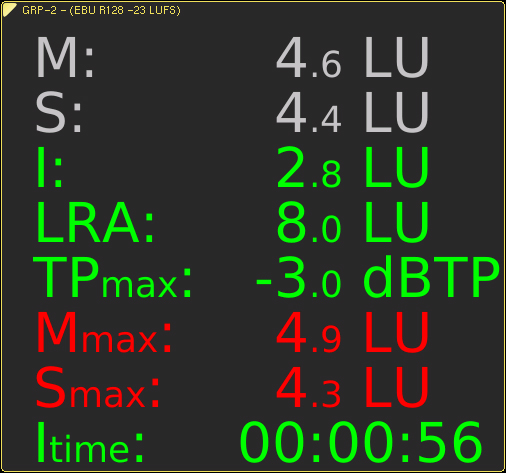
With the Loudness Num instrument you can monitor some or all relevant values of a loudness measurement on a numerical display: M, S, I, LRA, TPmax, Mmax, Smax, Itime.
|
||||
|---|---|---|---|---|
| Numerical display: |
|
|||
| The values displayed are based on the specifications of the selected Loudness mode which are described in the specifications of the Loudness Sum instrument. | ||||
The example shows all selectable value, based on a relative LU scale with the Target Level at 0 LU.
Move the mouse accross the display elements to get the corresponding descriptions.
The Loudness Num instrument provides numerical readouts of the following loudness measurements:
If needed, the numerical readouts of these individual loudness measurements can be activated or disabled individually. The values of current running measurements for I, LRA, TPmax Mmax, and Smax values will be colored green, those of stopped measurements yellow. If values are exceeding the upper limits, they will be colored red.
In order to conform to the individual loudness standard used or to other delivery standards, the measured program should read the „Integrated“ target level of this standard. Using EBU R128, it should read 0 LU on a relative scale or –23 LUFS on an absolute scale.
LRA (Loudness Range)
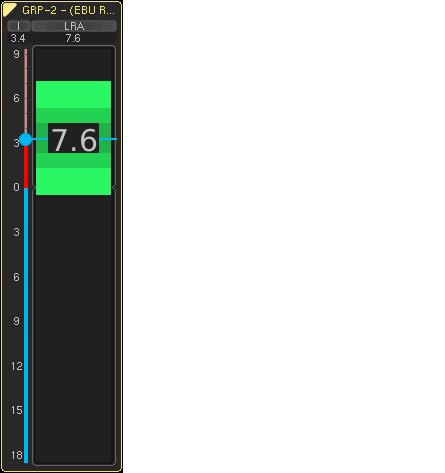
The LRA (Loudness Range) instrument displays a graphical representation of the loudness variances within short time periods. These are measured against the Loudness Range (LRA) descriptor specified in EBU R 128. It is used to show whether a program has a continuously constant loudness or a high variation between low and high level components. It allows for making assumptions on whether the program has seen or requires dynamic processing with regard to the intended distribution path.
|
||||
|---|---|---|---|---|
| Display: | Graphical display of the Loudness Range | |||
| Mode: | selectable: LRA Bar, MagicLRA, MagicLRA + I, MagicLRA + I + Num | |||
| Scale range: | selectable: 6 LU, 10 LU, 20 LU, 30 LU | |||
| LRA low range: | 2 LU; adjustable in the range from 1 to 20 LU in steps of 1 LU | |||
| Comfort zone: | 4 LU; adjustable in the range from 1 to 20 LU in steps of 1 LU | |||
| LRA high range: | depends on the selected scale range and the spread of the comfort zone | |||
| Colors: | selectable for each range | |||
The example shows four different audio groups each with another one of the four available modes.
Move the mouse accross the display elements to get the corresponding descriptions.
The LRA instrument provides a graphical representation of the Loudness Range (LRA) descriptor. LRA is a statistical method used to measure the variation of loudness across an entire program, where lower LRA values represent lower program dynamics. In this way, the LRA measurement can show whether a program has a continuously constant loudness (low LRA values) or a high variation between low and high level components (high LRA values).
There are no common target LRA values defined in the loudness standards, but some broadcasters or streaming services around the world define maximum LRA values in their delivery standards.
In general, the three distinct areas Comfort Zone (average LRA values), High Range (high LRA values) and Low Range (low LRA values) are used that can help to classify a program with regard to its LRA measurement and mark it with a distinct color.
The MagicLRA mode available in the LRA instrument uses a scale with a fixed centered zero position (corresponding to the target level) where the LRA bar spreads symmetrically from the 0 position and its length is a measure of the absolute LRA value.
The MagicLRA + I mode is a combination of LRA and Integrated (I) loudness measurements. The LRA bar has a moving, relative zero position that is anchored to the Integrated value measured. The MagicLRA + I + Num mode provides an additional display of the numerical LRA value on the zero position.
Dialnorm
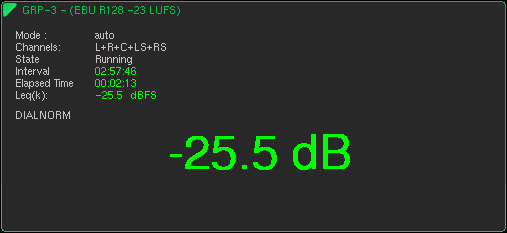
The Dialnorm instrument can calculate and show Dialnorm values from its digital input signals. Dialnorm is used in film sound mixing and describes the normalization of the dialog loudness level (dialogue normalisation) with respect to a certain reference monitoring level (–31 dBFS in surround applications).
Move the mouse accross the display elements to get the corresponding descriptions.
Dialnorm is used in film sound mixing and describes the normalization of the dialog loudness level (dialogue normalisation) with respect to a certain reference monitoring level (-31 dBFS in surround applications). The idea behind this scheme is that the perceived total loudness of a mixed audio signal may be determined and kept constant at the listening end by using the dialogue level (optimized for a combination of good intelligibility and minimal nuisance through excessive volumes) with its fixed loudness ratio in relation to music and sound effects as a reference.
Practical Use
Requirements